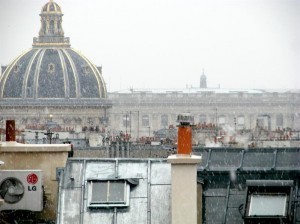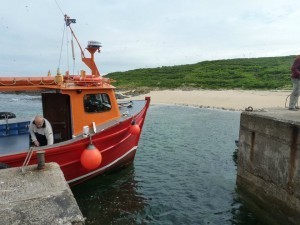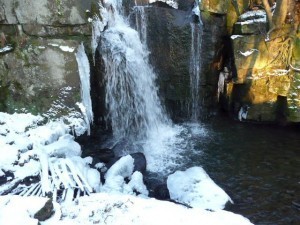Lisa Niver's Blog: We Said Go Travel, page 455
November 9, 2013
A Meditation on Paris
It’s nearly impossible to write about Paris while sitting in a Café on the Carrefour de L’Odeon, the oldest square in the city. I’ve lived here for nearly a year and everything still seems completely surreal, one big cliché, and there simply is no obvious place to begin.
One could write about the architecture of the city, uniform, windy cobbled streets, all the buildings limestone yellow, the grey tin roofs with bright terra-cotta chimneys, the windy iron balustrades overflowing with ivy.
One could write about the Boulanger around the corner, the heavenly smells that magically wafting through the winding back streets near Rue de Buci, and the fact that a baguette costs an entire euro is France’s biggest scandal in years. The picture-perfect gateaux with iced strawberries rimming the top are almost too flawless to dig into. Almost
One could write about the Seine, the snake winding and turning through the center of Paris, muddy and gross, yet still the draw of the city; criss-crossed by bridges made of everything from oak to stone. It’s illegal to even step in because of the filth, somehow the romance of the diner boats gliding by is not dimmed.
One could write about the gardens, with their meticulous (and almost ridiculous) lines of trees and flowers, where hundreds gather between 12 and 2 to eat lunch and disappear again back to the office just as quickly. As they eat, the smoke from their cigarettes wafts in small puffs up into cloudless sky. There are a few students who dare to bask in the sun on the strictly designated open grass areas. The fountains, some that trickle and some that roar, have the inevitable coating of pigeon poop.
One could write about the majestic monuments, the Eiffel tower, the Arc de Triomphe, their silent splendor drawing thousands upon thousands of camera—wielding tourists, or the towering cathedrals and peaceful churches with thousands of unique stories behind every stained-glass panel. The bells, ringing every day-not on the hour but in an indecipherable pattern of times.
There is also another side to her. It’s the Paris you seen when the sparkle wears off and the shadows of the real world settle in.
Paris is the homeless man who lives on the stoop next to my building, calling out ‘ma princesse’ every time I walk past him in the morning. She is the half eaten pieces of baguette lazily strewn around on the street outside of the bakery. At the flower shop on Rue des Fleurs, every morning someone spends at least three hours meticulously arranging and re-arranging the display, only to have it knocked down by a tourist on a bicycle. The flood in the streets caused by the street-cleaners opening the gutters to wash away the city filth- most of which is cigarette butts.
Paris is the taxi-driver, full weight pressed on the horn of his white painted 1992 Mercedes, opening the window to yell at a tourist J-walking across boulevard St. Germain, the plume of cigarette smoke spilling out of his window threatening to choke the school children walking by. He weaves his way around mopeds and garbage in the street in a rush to get home to his wife. Or to his mistress.
Paris is the woman dressed in nothing but rags and spiky heels, calling out to anyone outside the Bois de Boulogne at 3 AM on a Thursday morning. Their hands shake as they bring their cigarettes to their mouths, the red tip illuminating the smeared makeup and clumped hair sticking to their faces. The men drive by slowly, their gravely voices calling out and the women’s scratchy replies.
Paris is the swat team brought on to Europe’s most prestigious university campus to quell an uprising of students demanding better benefits while they struggle to become the leaders of this generation. The chanting, the kicking, the screaming and flailing. The inevitable shutting-down of the public transit system for the next day or two because of a strike.
Even with all her flaws, Paris makes you want to put on your best clothes and dance in the streets. She makes you wonder at the history and beauty in the every-day. She makes you want to be a part of a great love story. She makes you want to be great at something. Most of all, she makes you want to make her all your own.
About the Author: Lisa Gabrielson is a recent college graduate with a passion for travel, writing, photography, and sailing. She has traveled all across the Caribbean, North America, and Europe, including an 11-month stint as an Au Pair in France. She is currently an Account Executive at a small marketing firm in the DC area, and travels back to her hometown of Boston regularly. You can follow her on Twitter or Tumblr,
The post A Meditation on Paris appeared first on We Said Go Travel.
November 8, 2013
India: My Karma Ran Over My Marriage!
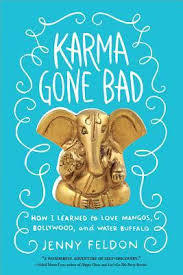 In Jenny Feldon’s novel, Karma Gone Bad, she shares losing herself among the sights, sounds and overwhelming smells of India. Through her tumultuous stories of making life work overseas as a newlywed, she nearly channels Carrie Bradshaw from “Sex in the City” if she appeared in Eat Pray Love.
In Jenny Feldon’s novel, Karma Gone Bad, she shares losing herself among the sights, sounds and overwhelming smells of India. Through her tumultuous stories of making life work overseas as a newlywed, she nearly channels Carrie Bradshaw from “Sex in the City” if she appeared in Eat Pray Love.
Feldon knows she is a New Yorker through and through; her essentials to carry-on the plane to Hyderabad are “four pairs of designer shoes, two hundred manuscript pages of my novel-in-progress, an assortment of cocktail dresses and a small white Maltese named Tucker.” Her husband, Jay, has a professional opportunity but what will Jenny do? As the twenty-seven year-old recounts, “My wanderlust was satisfied with a ride on the R train to Brooklyn. Ashrams weren’t really my style. I lived by Zagat, not Lonely Planet.” As a long-term traveler, I wondered how would Jenny and Jay adapt?
They initial impressions were not surprising. As she said on arrival, “we stepped out of the airport and into absolute chaos. I felt like an exotic zoo animal on display, but with no cage to protect me from the tidal wave of aggressive curiosity.” For our three months in India, several people told me, “You will love it and you will hate it.” Feldon’s voyage definitely started with hate. As she wrote, “My clothes were wrong, my communication skills poor, my sense of direction unreliable. I hadn’t even so much as glanced in the direction of my computer.” Her early hopes of being the perfect housewife and writing every day are daunted by the drama of life in India.
The beginning is very challenging. She yearns to believe in herself as an expat, “What could be more exciting, more sophisticated than becoming a seasoned traveler, a citizen of the world?” but wallows:
“Here, I was no one. A parasitic extension of my husband, a hanger-on in the world of corporate transplants. What if we never got used to it? What if it got worse instead of better? What if saying yes to the greatest adventure of our lives was really the worst mistake I’d ever made?” Wondering and worrying if it will ever get better dims her ability to be a good wife and friend.
At some point, she learns her new friend, Alexis, is also having trouble adjusting and in her relationship. When she is honest, she realizes, “Some days I think Jay might be sorry he married me.” Feldon candidly shares her troubles and her eventual triumphs. “Spending entire days being stared at and misunderstood— ignorant of the language, ignorant of the culture—was making the old, charming me disappear. Frustration and bitterness hung over my head like thunderclouds, coloring my moods dark.“ Learning to live on another continent with constant power outages, monsoons, lack of conveniences and misunderstanding take Feldon to the edge of the abyss, watching her climb back to personal and professional success is heartwarming and inspirational.
At first in India, she could not get grounded. She felt, “Infamous and invisible at the exact same time. With no familiar world to tether myself to, I felt like a broken balloon in the sky, spiraling toward the earth in a free fall, desperate for a gust of wind that would lift me up again. In Hyderabad there was no pyramid, no supporting cast of loved ones to keep us afloat in a sea of uncertainty. All those people were thousands of miles away. “ Most people live their lives without questioning what is important. Stripped away from family, friends and familiar surroundings Feldon must decide what are her priorities and fight for them.
She chooses to “Love it for what it is” her new mantra for her marriage and her life. She realizes, “It may not have been the journey we planned for, but it was still the experience of a lifetime.” Sometimes life is like “one big burnt, misshapen cookie—delicious in spite of its imperfections. Or maybe because of them.” I highly recommend Feldon’s voyage as an expat, as a newlywed and as a guide for finding your way.
The post India: My Karma Ran Over My Marriage! appeared first on We Said Go Travel.
Farne Islands,UK: The Birds
He didn’t want to go. He eyed the fishing boat doubtfully.
“What if it sinks?”
“It won’t.”
What if there’s a storm?”
I looked out to sea. It was as still as a millpond. “There won’t be.”
“I might get sick.”
“I doubt it.”
I might get blown overboard.”
I sighed. My son, Patrick, was stubborn – and his imagination knew no bounds. “I’ll make sure you won’t.”
We were standing on the jetty at Seahouses on the coast of Northumberland. Most people came to Seahouses to take a boat trip to the Farne Islands.
The Farne islands make up a chain of reefs that include the romantically named Knoxes Reef and the East and West Wideopens, joining up as one when the tide is at its lowest.
I nudged Patrick towards the steps that led down to the waiting vessel.
“Come on, Patrick. It’s perfectly safe.”
Patrick wasn’t about to give up. “Grace Darling had to save people who’d been ship-wrecked off Farne.”
“How do you know that?”
“My teacher told me.”
“Well … only because there was an almighty storm. Look out there. There’s hardly a ripple on the water.”
Patrick continued to drag his feet.
“Come on. We might see seals. They’re often swimming off-shore or basking on the rocks.”
“There might be sharks.”
It was pointless. I sighed and said, “Too late, we’ve bought the tickets.”
The boatman showed us the lighthouse where Grace Darling had lived and the site where she had rescued the ship-wrecked. So far Patrick hadn’t been sick – or fallen overboard. It didn’t look like we were going to sink either. He began to relax.
The boat made its way back to Inner Farne and the National Trust bird sanctuary.
“I can’t wait to see the puffins,” Patrick said.
“Hope you’ve got hats with you?” our boatman interjected with a glint in his eye. I wondered why: it wasn’t particularly cold. It wouldn’t be long before we’d find out.
We’d arrived on Inner Farne right in the middle of the breeding session. Hundreds and thousands of terns, guillemots, shags, cormorants and puffins were nesting. Some chicks had already hatched. It was a birder’s paradise – and soon to be our hell.
Climbing the steps up onto the Island, we began to comprehend the boatman’s question. Before long we felt a rush of air; then a sharp jab. A small black-hooded bird with blood-red beak and claws banked before swooping in again, its needle-thin beak at the ready: Peck, peck, peck.
Tens of Arctic Terns lined the edge of the pathway just inches from our feet. As we approached the nests the protective females rose up in attack. We clutched each other, our hoods up, our heads down, hands flapping, but still they came: circling, squawking, rushing at us.
“No one said we’d been invited as extras on a remake of Hitchcock’s ‘Birds’!” I cried.
We laughed hysterically, the Terns giving us an adrenalin rush to match all the thrills of the fun fair. When we tried to outrun the birds, they chased after us, swooping in around our heads, their pecking increasingly urgent and vicious.
Dashing for St Cuthbert chapel, we sought out sanctuary. In 676 St Cuthbert had introduced laws to protect the birds on the island – but today the saint was offering us humans no protection. As soon as we left the church again, the Terns were waiting, ready to ambush us with a new strategy.
Splat! Slimy bird poo slithered down our coats.
We continued on up the path, leaving the Terns behind. Over the rise and we found the altogether calmer puffins huddled in groups like old men on street corners. If the Arctic Terns were the stars of a Hitchcock horror film, the puffins were cartoon characters with their kohl-streaked eyes, chunky orange webbed feet and flinthead beaks. Some sat on the cliffs, peckers spilling silver sprats, whilst others flapped frantically in the air with their undersized wings before making awkward ‘upright’ landings.
The comerants were a mix of comedy and horror. They perched on high-rise twiggy nests, peering out from punk-like tufts. But really, they were the Lord Voldemorts of the bird world with their raven-black coats, snake-green eyes and poison-mustard markings oozing from their beaks. And when they extended their great black wings and flapped menacingly, there was no doubt: they were horror, not comedy.
“Mum,” Patrick said as we headed back down the hill towards our waiting boatman. “Can’t we stay overnight? Please? It’s wicked here.”
About the Author: Helen Moat spent her childhood squished between siblings in her Dad’s Morris Minor, travelling the length and breadth of Ireland. She’s still wandering. She blogs at: http://moathouse-moathouseblogspotcom.blogspot.co.uk/
The post Farne Islands,UK: The Birds appeared first on We Said Go Travel.
November 7, 2013
Adios Los Angeles, Hola Panama
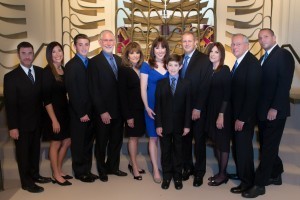 Adios Los Angeles, Hola Panama! (from our latest news)
Adios Los Angeles, Hola Panama! (from our latest news)
Being in Los Angeles for our family event (Koby’s Bar Mitzvah) was wonderful. We were fortunate to spend time with our relatives and share in a special celebration. We also saw many friends and had a fantastic live event at Luxe Sunset Boulevard Hotel. We appreciate your participation in Oahu at Lotus Honolulu and in Los Angeles at Luxe Sunset Boulevard Hotel and online for our webinar about Exotic Burma for our Festival of the Pacific! We will share videos of all events as soon as they are available.
We have NEW VIDEOS to share! Please enjoy: our video book trailer of Traveling in Sin,our first night in Palau (Mingles So Thai), Palau Government House with Hula Hooping, Palau Jungle River Cruise, Palau Museums,and Baby Poi in Thailand. We will share our stories from this summer as the articles get published.
We are currently in Panama. People always ask us about our luggage or what is in our backpacks. When we checked in for our flight from Los Angeles to Panama City we had 19.4 kilos. (Math problem: 1 kilogram is 2.2 pounds. 8.4 for George and 11 for me, or 42.7 pounds for both of us.)
Our visit to the Panama Canal and Casco Antiguo (see George’s photo below) was history come alive. We hiked in Santa Fe (photo below, got eaten by chitras) and enjoyed the festival De Patria on Nov 3 in Boquete. I think that the best thing about travel is to be able to understand what is going on and how it relates to your life and the lives of local people. George and I feel so fortunate to be able to continue our travels and grow our website. Thank you so much for your support!
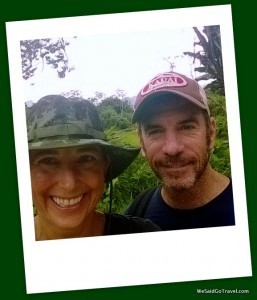
Hiking in Santa Fe, Panama
We appreciate all of you who read our newsletters, articles, website and BOOK! Thank you to everyone for your support of our journey and all our writing. Connect with us on Facebook, Google+, LinkedIn, Pinterest , SlideShare, Twitter, and YouTube.
Happy and Safe Travels! Gracias!
Lisa and George (Click here to sign up for this newsletter. )
More articles to enjoy: Thank you to Mountain Travel Sobek for interviewing us for their ADVENTURE TRAVEL series! Click here to read the interview! Did you know our site was listed in the TOP 100 Travel blogs! Thanks Nomadic Samuel!
Have you seen our new video book trailer for Traveling in Sin?
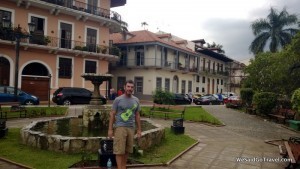
George in Casco Antiguo
The post Adios Los Angeles, Hola Panama appeared first on We Said Go Travel.
My Karmic Connection with Cambodia
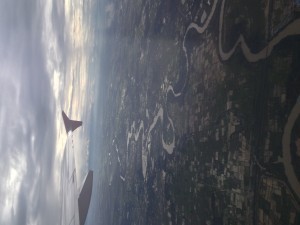 Cambodia has been on my mind for the last six months, pretty much all the time, but it’s hard to say why. This interest-turned-passion developed within a few hours and has stayed on since. It started with a book called “Survival in the Killing Fields”, written by a Khmer Rouge Survivor, Dr Haing Ngor. Dr Ngor went on to star in the movie “The Killing Fields” which is why you may have heard of him. I had not, and I was not aware of the movie or its story. This book changed all of that.
Cambodia has been on my mind for the last six months, pretty much all the time, but it’s hard to say why. This interest-turned-passion developed within a few hours and has stayed on since. It started with a book called “Survival in the Killing Fields”, written by a Khmer Rouge Survivor, Dr Haing Ngor. Dr Ngor went on to star in the movie “The Killing Fields” which is why you may have heard of him. I had not, and I was not aware of the movie or its story. This book changed all of that.
But then I thought about why I, of all people, should be so affected by a book to the extent that for a few months, it was all I was talking about to anyone who cared to read or listen. I thought about the authors I’ve been reading and how they are related to Cambodia, I thought about what I’ve read and I thought about Cambodia as a country and its people and culture. Most authors or film makers who have produced anything related to Cambodia bear some relation to the country or its culture in some way. Random people like me exist, but are rare and no one takes them seriously anyway.
“What is my reason?”, I am asked. I am Indian. I live in Malaysia and work as a Doctor. Till just five months ago I had no plans of even visiting Cambodia apart from a “bucket list” desire to see AngkorWat. I had never heard of anyone related to Cambodia. I am 38 years old and I knew nothing about a country that was the victim of a genocide that must surely rank alongside The Holocaust in many ways and in many others, stand apart in its brutality and near-destruction of an entire country and its identifying tenets of civilization-family, religion and way of life. It was a sledgehammer discovery, to put it mildly.
Cambodia took a hold on me. It led me to visiting Phnom Penh, an experience that comes once in a lifetime. I met people whose memories will always linger and and I felt peace and a sense of utter spiritual calm where in fact, I had gone to see places known for brutality and murder of historic proportions.
Cambodia, I realize now, is personal. The story stays with me, the images and memories-of old Cambodia, of the photographs of the S21 victims hanging there, of the evacuation of Phnom Penh, of the “Killing Tree of Choeung Ek”, of the rare footage from the Khmer Rouge labour camps-they haunt me. I am awe-struck at how a people subject to such complete and utter subjugation, terror and destruction can be so welcoming, so warm, so genuine. I despair at the problems that currently face Cambodia but I am grateful that there is a Cambodia at all.
Sadly, for a country that has a rich heritage and a glorious past, it is The Khmer Rouge genocide of 1975-1979 that defines Cambodia’s history now-everything since is judged in its context- but although Haing Ngor introduced me to the Khmer Rouge and their atrocities, he also weaved in aspects of Cambodia’s culture and customs that impacted his life-respect for elders, the value of family, traditional Asian values-a culture that unsurprisingly is very close to my own Indian upbringing. These values were shattered by the Khmer Rouge, the country’s very fabric was torn to shreds and the threads that bind the cloth now are tenuous but they are there. I read about the country’s geography and people-the vast green rice fields, the poor but happy farming community working for themselves, the old world charm of Phnom Penh, the arts and dance heritage of Cambodia, the beautifully peaceful countryside dotted with sugar palms and ringed with hills and mountain ranges. The scenes I describe above are familiar to me-they could have been from anywhere in India or indeed, in South East Asia. Cambodia feels like home and in my recent visit there, I felt I was at home too.
Modern life has undoubtedly changed much of the scenery and that is to be expected but the Cambodia of today has risen from the Stone Age, quite literally. How can that not be inspiring?.
By all rights, Cambodia should be extinct. But of course, it’s not. Go and see for yourself what a miracle means.
I am of course, no expert in this field and maybe that is a good thing. I cannot look at Cambodia with academic detachment and I am grateful for that. Now, if I am still asked “Why Cambodia”, I tell them that in a previous life I was Cambodian.
Karmic connection. That is what it is.
That is why I love this little piece of heaven.
About the Author: Nishikanta Verma: I am an Indian doctor currently residing in Malaysia. I am passionate about all things related to Cambodia and also have current interests in World History, Buddhism and Quantum Physics. I am married with one daughter and another on the way. Twitter: @jipmerdays.
The post My Karmic Connection with Cambodia appeared first on We Said Go Travel.
Costa Rica: Sustainable Tourism? Sustainable Spouse?
We have left Panama for Costa Rica and are very excited to soon meet the father of eco-tourism, Michael Kaye who is also the founder of Costa Rica Expeditions.
He offered to share his story from the Huffington Post: What Do Being Sustainable and Being Faithful to Your Spouse Have in Common?
They are both worthwhile, they are both difficult, and they are both routinely lied about.
This post is about sustainability and lies.
I got inspired to write about this topic by the sign below that I saw in a hotel bathroom the weekend before last.
Next to the toilet, there was one of those pretty little covered metal garbage cans that I always knock over when I try to use the foot pedal that opens the cover. Presumably the feminine hygiene products, etc. were to be deposited in it.
After reading the sign, I got to wondering whether the way the feminine hygiene products, etc. were disposed of after they were deposited in the garbage can was any kinder to the environment than flushing them down the toilet. No one at the hotel knew.
It turns out that the real reason the hotel did not want feminine hygiene products, etc. put in the toilet is that they blocked the septic system and caused flooding. That seemed to me to be necessary and sufficient reason to not put feminine hygiene products, etc. in the toilets without having to mention the much-invoked environment.
This kind of increasingly ubiquitous lie about sustainability is usually more thoughtless than intentional. Since everybody else does it, we reflexively cite the environment as a reason to do things. In many cases our purpose is much more to show the world that we are environmental good guys than to actually influence behavior.
Take, “Please consider the environment before printing this email.” Has anyone ever forgone a hard copy that they really needed for environmental considerations? If you don’t really need a hard copy, aren’t there more compelling reasons for not bothering to print it than the environment.
There is another kind of being sustainable lie that is much more damaging — the lie that being sustainable is good marketing. I am most familiar with this lie in travel, but I have seen it crop up in many other fields as well.
This second type of sustainability lie is particularly insidious because initially being sustainable can be good marketing, but (read this slowly) marketing through sustainability is not sustainable.
It’s not as complicated as it sounds. Here’s how it works:
The real market for sustainability is the media, not the ultimate consumer.
The media loves interesting stories about sustainability.
Businesses that are able to create these types of stories get in the media.
Businesses that get positive stories in the media get customers.
The fact that some sustainable businesses have lots of customers creates the illusion that the customers are choosing theses business because they are sustainable, when they are actually choosing them because they are in the media.
These businesses are held up as poster children for sustainability is good marketing.
This induces other businesses to adopt sustainable practices to get more customers only to find that the media has no interest in the second businesses who are doing the same things that they (the media) already featured.
To get ink you have to come up with a new sexy way to be sustainable.
Before long new sexy ways to be sustainable are more expensive to implement than the benefits from the media exposure.
This inflationary sustainability spiral leads to lying about sustainable practice, AKA green washing.
At least for a while the media, hungry for feel good sustainability stories is not inclined to delve too deeply.
Then, when the media loses interest in feel good sustainability stories, because they’ve, “been done,” they turn to green-washing exposés, which give sustainability a bad name.
And that’s why marketing sustainability is not sustainable.
This brings me to the other thing that being faithful to your spouse and being sustainable have in common: The more you do them and the less you talk about them the better.
If you talk about being faithful to your spouse, people will think of John Edwards and Arnold Schwarzenegger.
If you talk about being sustainable, people will wonder what kind of car you drive.
Where to find Michael Kaye:
http://www.costaricaexpeditions.com
http://www.tortugalodge.com
http://www.monteverdelodge.com
Blog:http://www.vacationtimeisprecious.com
The post Costa Rica: Sustainable Tourism? Sustainable Spouse? appeared first on We Said Go Travel.
November 6, 2013
Japan: Learning to Fly
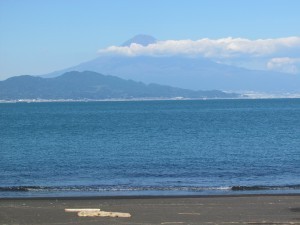 Mount Fuji was stunning in its symmetry. I stood across the gulf, on a dock in Shizuoka, enveloped by a mesh of white cottontail plants bending with the breeze. Black sand spread before me, coarse grains eroded from the basaltic rock carried ashore from Mount Fuji, Japan. Debris had accumulated in the brush – cardboard, aluminum cans, chunks of Styrofoam coolers – debris from fishing trips past, debris neatly consolidated and tucked away by small Japanese fishermen. They said hello as they passed with their tall boots and their lines, quiet men and women welcoming two foreigners into their hometown.
Mount Fuji was stunning in its symmetry. I stood across the gulf, on a dock in Shizuoka, enveloped by a mesh of white cottontail plants bending with the breeze. Black sand spread before me, coarse grains eroded from the basaltic rock carried ashore from Mount Fuji, Japan. Debris had accumulated in the brush – cardboard, aluminum cans, chunks of Styrofoam coolers – debris from fishing trips past, debris neatly consolidated and tucked away by small Japanese fishermen. They said hello as they passed with their tall boots and their lines, quiet men and women welcoming two foreigners into their hometown.
After nearly a year in Japan, Shizuoka felt more familiar than foreign, from the clipped Japanese chatter wafting over from the parking lot to the miniature vans and trucks packed to the brim with fishing gear. Every few minutes, a faint roar erupted, carried in from the little league baseball game I had passed on the road on the walk in. Far away from the cement and concrete grayness of Nagoya, Shizuoka’s miles of green houses, colorful flowers, and wide open fields were a (literal) breath of fresh air. From the opposite direction – perhaps a distant school or soccer field – came a cadence of bongo drums and brass instruments, the tinny voices of children wafting across the plains.
Mount Fuji, or Fuji-san, has long been a sacred mountain. The native Ainu revered the great peak. Shintoists consider the peak sacred to the goddess Sengen-Sama, who embodies nature. The Fujiko sect believes the mountain is a being with a soul. Japanese Buddhists believe the mountain is the gateway to a different world. It is the most climbed mountain in the world; over 100,000 people trek to its summit each year.
I had come not to hike the mountain but to take in its beauty, to absorb the panoramic view hikers are not able to capture as they traverse it. 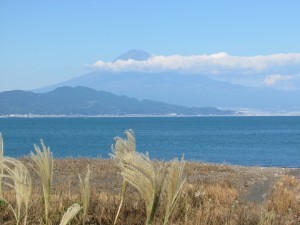 Though Fuji-san’s peaks were snow-less the sky was clear, allowing onlookers to absorb the mountain in all of its glorious symmetry.
Though Fuji-san’s peaks were snow-less the sky was clear, allowing onlookers to absorb the mountain in all of its glorious symmetry.
I made my way down the beach, weaving around waves and fishing lines. High above the water, a tiny plane cut through the sky. White with red stripes, the plane whizzed as it passed, a steady trail of smoke snaking behind it. It flew with a wobbled, frenetic energy, as if eager to get to its destination.
It took a few minutes to register the plane was a toy, a stunning replica of a small passenger plane, controlled by someone I had no sight of. I watched, awestruck, as the engine choked and the plane spiraled, nose-first, toward the water. It wailed and sputtered and, mere inches above the waves, pulled its nose up to the sky, showing off in a series of loop-the-loops before shooting off down the coast.
I thought immediately of my grandfather, my paternal grandfather, now a decade deceased. My grandfather had an affinity for planes, for helicopters, for things that flew. As a kid he had fashioned a makeshift parachute to his back and jumped off the roof, to the horror of my great-grandmother. As a young man he flew planes to train for the war, but ultimately spent Christmas of ’44 on the ground, driving tanks, as the battle bulged onward. As a father of four and a grandfather of seven, he flew small planes recreationally, occasionally taking one of the kids up for a ride, to the horror of my grandmother. Whenever she scolded my grandfather for his antics, he would smile sweetly, tip his head to the side, and say “I love you, dear!”.
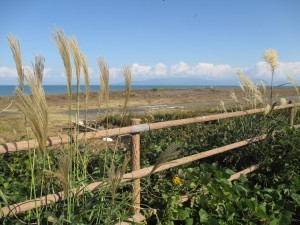 My grandfather was interested in physics, in the way things rose and fell, the way they found their way back. His thirst for knowledge was never satiated, his curiosity without bounds, his desire to push the limits tempered only by his obligations as a husband, a father, a grandfather. Sundays I would tear through the side door, yell hello to my grandmother and make my way downstairs to find Grandpa. I could picture the scene before I saw it: Grandpa standing in his small workshop off the basement bathroom, talk radio chattering in the background. I would see his back first, his head bent over the wings and tiny parts of the model planes he crafted from balsa wood, the planes we would later chase through the field. Planes that – if you threw them correctly, with just the right speed and just the right arc – landed smoothly, quietly, in the shin-high grass.
My grandfather was interested in physics, in the way things rose and fell, the way they found their way back. His thirst for knowledge was never satiated, his curiosity without bounds, his desire to push the limits tempered only by his obligations as a husband, a father, a grandfather. Sundays I would tear through the side door, yell hello to my grandmother and make my way downstairs to find Grandpa. I could picture the scene before I saw it: Grandpa standing in his small workshop off the basement bathroom, talk radio chattering in the background. I would see his back first, his head bent over the wings and tiny parts of the model planes he crafted from balsa wood, the planes we would later chase through the field. Planes that – if you threw them correctly, with just the right speed and just the right arc – landed smoothly, quietly, in the shin-high grass.
He had long dreamed of hang-gliding. As a kid, I pictured him soaring off a cliff in northern Michigan, a stunning blaze of brightly colored sails against the reddening sky. But by the time activities like hang-gliding and sky-diving went mainstream – meaning, they were administered by professionals and deemed, for the most part, “safe” – grandpa was a tad too old. He was mentally and physically solid, sound as an ox, but his wildest times were behind him.
In honor of my grandfather’s seventieth we found the next best thing: a hot air balloon ride. I was eight at the time and too light to accompany him. I stood close to the basket as the crew removed the stakes from the ground, as the ropes wriggled free. I waved, heart pounding, as propane blasted up into the balloon, as the long nylon gores filled with air. When the basket left the earth, shifting westward with the wind, I ran alongside it. I must have run a half mile through that field, watching as my grandfather, beaming from ear to ear, became smaller and smaller, watching until he became a speck high above the treetops, the vibrant red balloon a cape carrying him, finally, onward and upward.
The post Japan: Learning to Fly appeared first on We Said Go Travel.
England: The Lost World of Arkwright
The stillness is unnerving in this dark, dank, virile valley. Nature is out of control here: Ivy, moss and lichen are choking stone and tree, swallowing the stream even.
This place was once very different. I catch glimpses of the past through snaking roots and shrubbery: a gable here, an empty window there, a missing door, a roofless ruin, a right angle of walls instead of a rectangle, a pile of rubble. Further up, there’s the curved wall of an empty paint vat, a single surviving flue and a wheel pit with an empty linchpin. In an archway, there is the worn-away convex curve of stone where a millstone once ground.
The Derwent Valley Mills in Derbyshire, England is a World Heritage Site. They are great monuments to the Industrial Revolution, and to one of its founding father, Richard Arkwright. Just off the main Derwent trail is Lumsdale, a forgotten wooded gorge close to the town of Matlock. Few venture here yet it’s a place of strange decaying beauty. The first mill was built here in the 1600s. By the height of the Industrial Revolution, there were at least 7 mills crammed into this narrow dale.
I close my eyes and breathe in the faint smell of water hitting cool air, rock and fern. The rotting vegetation from last winter still pervades the air, mingled with the scent of fresh shoots and buds. I try to imagine what it would have been like here centuries ago when the mills were still operating. And I swear I can smell the pungent aroma of ground minerals, the crunched bone of animal, the chaff of the wheat and the woven cotton. I listen. Through the sound of cascading water, I’m sure I can hear the grating millstone and the voices of mill workers hanging in heavy, dust-filled air. This place is full of ghosts.
I open my eyes again and continue the climb. “Hello.” An elderly lady calls to me. She’s carrying sheets of typed paper. “Would you be interested in my guided tour of the Lumsdale Arkwright Mills?” Her small eyes are bright with excitement. She makes her way over, her feet nimble, her body light. She trips over her words with a distinctive Scottish lilt. I don’t recognise her face but I remember her voice.
“We’ve met before,” I exclaim, “when I came up here last winter in the snow”. She has come to life with the spring and the excitement of her project. Back then, the winter snow had taken its toll as she had walked down the icy lane above the dale, hunched over, frail and vulnerable. Spring has a way of renewing life.
“I promise I will come,” I shout as I leave.
High above the dale, I look down at the waterfall that spills a hundred feet. Transparent pebbles of water bounce into the air. Below, the stream is bracken- brown. At the water’s edge, great green and russet slabs of stone sculpt the valley, like heavy, angular Russian monuments.
At the top, I sit by the last surviving mill pond of three. A black Labrador breaks the glassy surface of the water with his snout. The inverted landscape trembles. Mallards fly out of yellowed reeds. A flock of ravens rise up on the hillside in an echo.
Lumsdale. It’s a place that calls to me over and over.
About the Author: Helen Moat spent her childhood squished between siblings in her Dad’s Morris Minor, travelling the length and breadth of Ireland. She’s still wandering. She blogs at: http://moathouse-moathouseblogspotcom.blogspot.co.uk/
The post England: The Lost World of Arkwright appeared first on We Said Go Travel.
Confessions: Teacher or Traveler?
Thank you to the Huffington Post for sharing my story: Why So Many of America’s Teachers Are Leaving The Profession
John Owens in his book, Confessions of a Bad Teacher, shares that “America’s public school teachers are being loudly and unfairly blamed for the failure of our nation’s public schools.” As a 2012 nominee for the Presidential Award for Excellence in Math and Science Teaching and a veteran of public and private schools for the last twenty years, I have to agree but I was glad to hear someone else say it in print.
The vast majority of teachers are working overtime without the tools or budget to manage the plethora of issues inside and outside the classroom. On top of that, administrators who only compound the situation by micromanaging the wrong things make the lives of teachers completely untenable with their lack of support.
Most teaching preparation programs including the one Mr. Owens attended do not adequately prepare anyone for life in the classroom. For many beginning teachers, “It was as though I had just joined the circus as an apprentice clown and was immediately required to juggle plates, bowling pins, butcher’s knives, and axes all day long while walking along a tightrope in midair.” Teachers make more decisions per hour than any other job including what to do with a student who falls behind, manage students with learning or emotional problems, tailor each lesson every day to up to 125 students or more who are somewhere between illiterate and highly gifted.
Sadly some administrators, students and parents instead of partnering with teachers, blame “teachers which is easier than doing a massive system overhaul.”
CLICK HERE TO READ THE FULL ARTICLE ON THE HUFFINGTON POST (and read the comments!)
The article ends:
In Los Angeles, new teachers and old can find mentorship and engaging lessons with the Los Angeles Science Teachers Network. In response to an overwhelming situation in 2009, I created this network for professional development, support and camaraderie. Administrators cannot do everything and we all must participate to improve learning for the children. Do not listen to the blame. Do something about it. We are each responsible to do what we can. Write a blog, start a network, help a child and find a way to feel supported in the classroom. America needs you.
About the Author: Lisa Niver Rajna was a 2012 nominee for the Presidential Award for Excellence in Math and Science Teaching. She was the first teacher to appear on Career Day. She and her husband George are on a career break sharing their world adventures on We Said Go Travel.
The post Confessions: Teacher or Traveler? appeared first on We Said Go Travel.
November 5, 2013
Mountain Travel Sobek: Adventure Talk with the Rajnas!
Thank you to Mountain Travel Sobek for interviewing us for Adventure Talk! We are honored to be included in their adventure series!
Avid travelers and entrepreneurs, Lisa and George fell in love while exploring the world, and have continued to strengthen their bond while reaching out to inspire others to live their dreams. They are two educators with a passion for globetrotting, and their adventures have brewed their creation of We Said Go Travel, a site that has developed into a global community, where over 300 people have come to share their story. We had the chance to interview Lisa and George and uncover some of their story below:
1. When did you fall in love with travel?
George: I first fell in love with travel when I traveled with my parents as a young child on a road trip in Mexico, and during family trips to Israel and the Bahamas. I eventually truly fell in love with travel on my own when I traveled to Europe for the first time. I knew it was something I wanted to continue to do.
Lisa: My parents took my sister and I on a cruise to the Mediterranean when I was twelve. I loved being at sea and waking up each day in a new port. The waiter gave us huge bags of fruit to take on the bus to the pyramids; he was worried we wouldn’t find anything to eat. Riding a camel that day was an experience I have never forgotten, and I am still hungry for more adventures!
4. Tell us about your book, Traveling in Sin…would you describe it as your and George’s love story?
George: Yes. It is a memoir about our relationship and how it evolved during our year-long journey traveling, primarily in Asia from Indonesia to Mongolia.
Lisa: Our book starts with the actual emails we sent when we met online. From our first contact to spending 24/7 together on the road, we share the good, the bad and my tears on our journey. There are humorous moments and colorful characters.
Read the full interview: CLICK HERE
WATCH: video book trailer of Traveling in Sin:
The post Mountain Travel Sobek: Adventure Talk with the Rajnas! appeared first on We Said Go Travel.
We Said Go Travel
We Said Go Travel is a global community of over sixteen hundred writers with articles from every continent.
Stories are shared with photos and video from a perspective of the transformative power of travel. We Said Go Travel has hosted live and online events as well as travel writing contests around the world. ...more
- Lisa Niver's profile
- 57 followers


